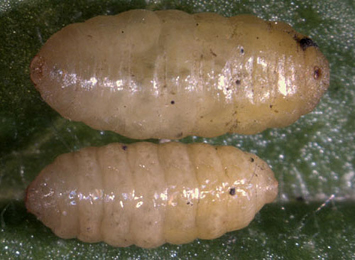|
||||||
|
PETROSELINUM. Garden and Corn Parsley. [Apiaceae] |
|
Two species of Petroselinum, the native Corn Parlsey (P. segetum) and the introduced Garden Parsley (P. crispum), are recorded in Britain. Two British miners are recorded on Petroselinum. A key to the European miners recorded on Petroselinum is provided in Bladmineerders van Europa. |
Key for the identification of the known mines of British |
1a > Leaf-miner: Blotch mine |
1b > Leaf-miner: Linear mine. |
2a > Leaf-miner: A large blotch, yellow or brown, preceded by a short corridor that in the end mostly is completely overrun. Generally several larvae share a mine. Especially in fresh mines the green primary and secondary feeding lines are well visible. Pupation outside the mine. Hering (1957a) warns that the mines cannot be separated from those of the rare Cryptaciura rotundiventris. Mine is deep and leads to a blotch, which is usually coloured yellow or brown (British leafminers) |
 Euleia heraclei pupariria Image: © Willem Ellis (Bladmineerders van Europa) |
|
Euleia heraclei (Linnaeus, 1758) [Diptera: Tephritidae]. |
3a > Leaf-miner: A short, irregular, linear upper surface mine on any part of the leaf. Also recorded from young pods (Bland, 1997a). Long corridor mine. As a rule the first part of the mine is lower-surface, the later part upper-surface. Often the loops are so dense that a secondary blotch is the result. Because upper- and lower-surface corridor segments often cross, the mine obtains a strange array of transparant patches. There is no association with the midrib. Frass in strings and thread fragments. Pupation outside the mine; exit slit in upper epidermis. Mine not associated with the veins or midrib of the leaf (It is this character which enables distinction from another Agromyzid pest species - Liriomyza huidobriensis). The larvae may leave one leaf (if not large enough) and enter another leaf, via the petiole). It exits the leaf to pupate through a semi-circular slit in the upper surface of the leaf. |
|
Liriomyza bryoniae (Kaltenbach, 1858) [Diptera: Agromyzidae]. |
| Last updated 06-Jul-2019 Brian Pitkin | ||
